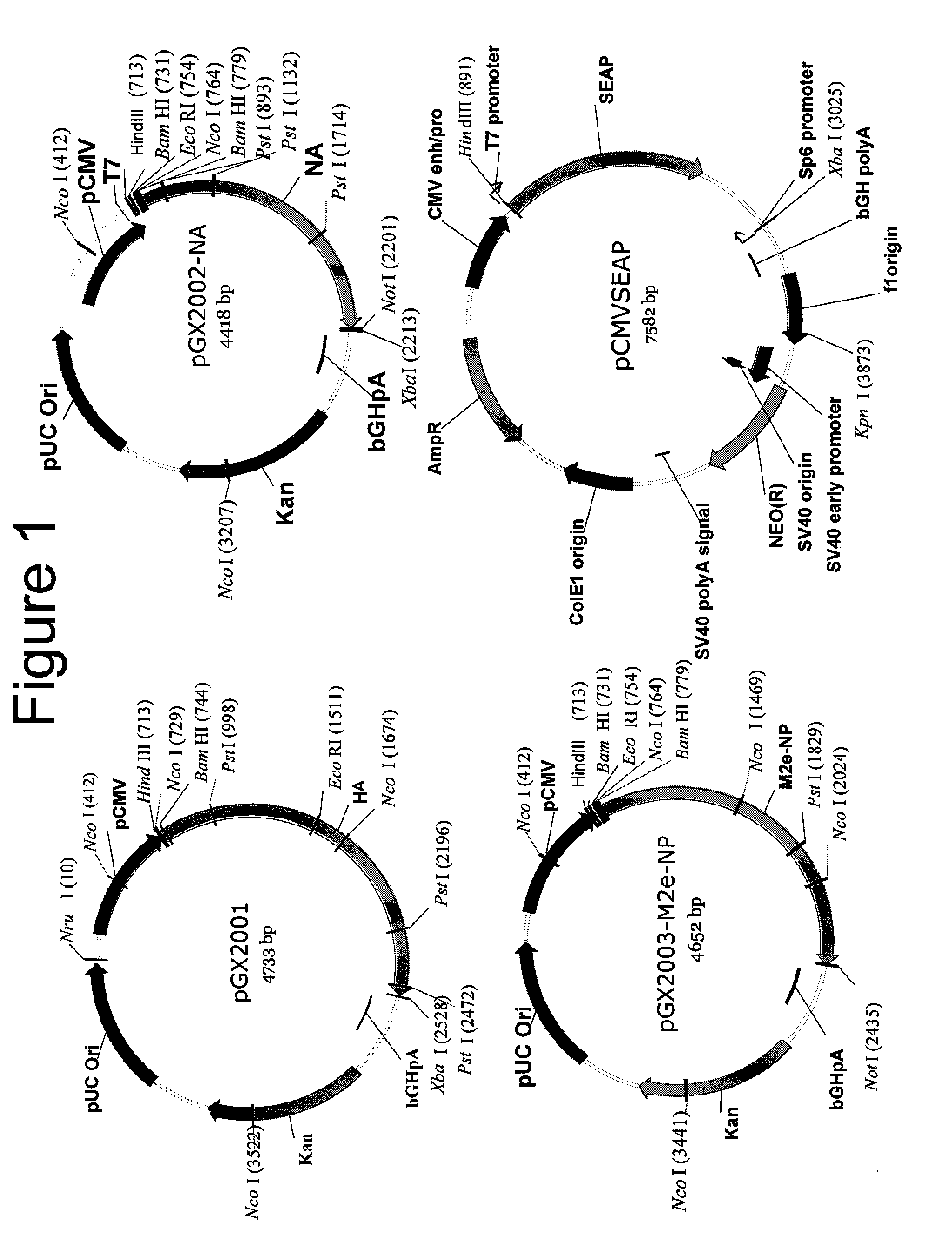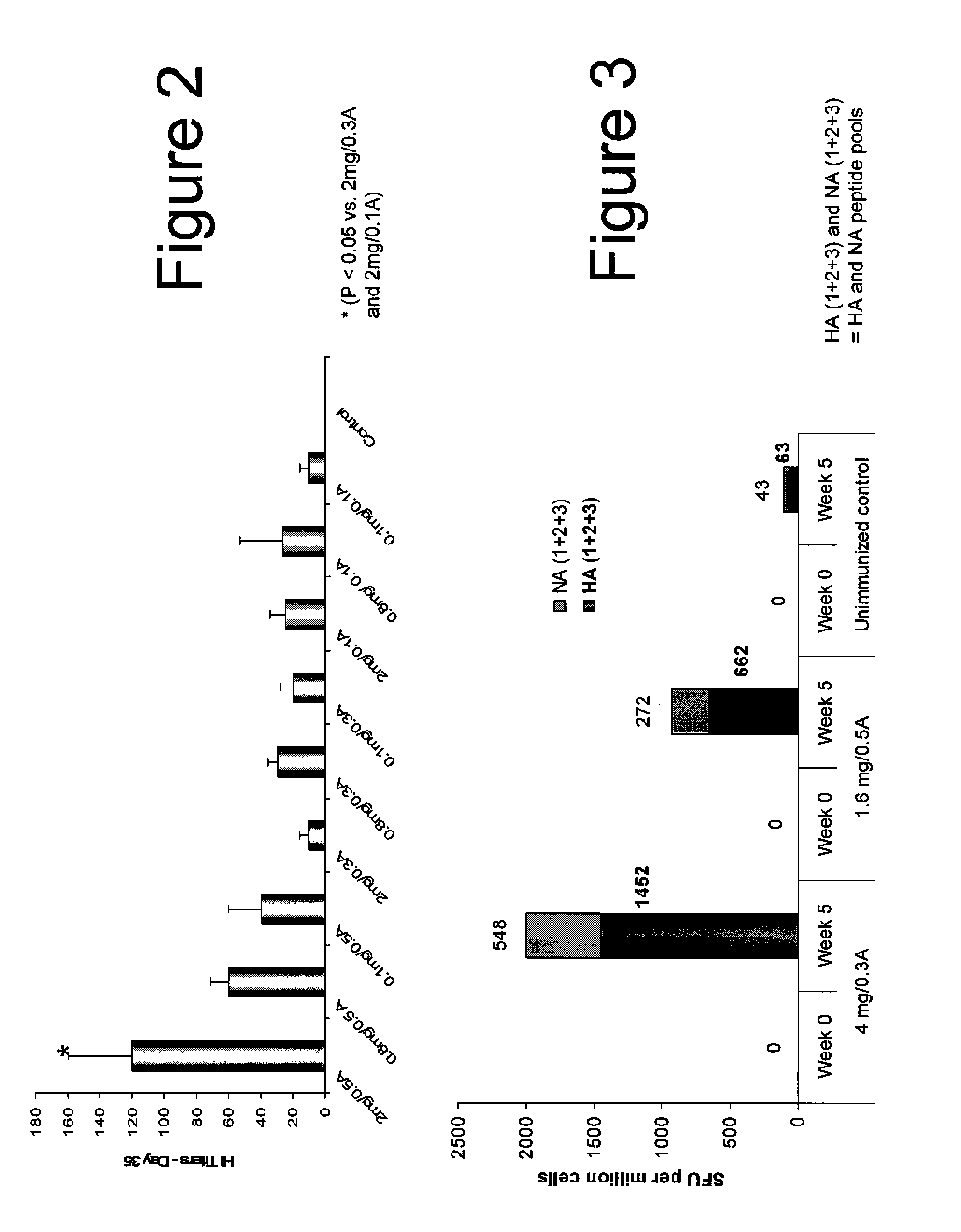Novel vaccines against multiple subtypes of influenza virus
a vaccine and influenza virus technology, applied in the field of influenza vaccines, can solve the problems of poor clinical outcome of infants and older or immunocompromised adults with the viral h5n1 strain, limited protective effect of vaccinations, and limited vaccinations
- Summary
- Abstract
- Description
- Claims
- Application Information
AI Technical Summary
Benefits of technology
Problems solved by technology
Method used
Image
Examples
example 1
Plasmid Constructs
[0089]A ubiquitous cytomegalovirus (CMV) promoter drives the expression of human secreted embryonic alkaline phosphatase (SEAP) reporter transgene product in the pCMV-SEAP vector. Plasmids were obtained using a commercially available kit (Qiagen Inc., Chatsworth, Calif.). Endotoxin levels were at less than 0.01 EU / μg, as measured by Kinetic Chromagenic LAL (Endosafe, Charleston, S.C.). Consensus HA and NA constructs were generated by analyzing primary virus sequences from 16H5 viruses that have proven fatal to humans in recent years, and over 40 human N1 viruses. These sequences were downloaded from the Los Alamos National Laboratory's Influenza Sequence Database. After generating the consensus sequences, the constructs were optimized for mammalian expression, including the addition of a Kozak sequence, codon optimization, and RNA optimization. These constructs were then subcloned into the pVAX vector (Invitrogen, Carlsbad, Calif.). Unless indicated otherwise, plas...
example 2
Treatment of Pigs
[0090]Pigs were divided into 10 groups×4 pigs per group for a total of 40 pigs (Table 1). Pigs were acclimated for 4 days, weighed and ear-tagged. On Study Day 0, pigs were weighed, bled and anesthetized using a combination pre-anesthetic for pigs—ketamine—(20 mg / kg), xylazine—(2.2 mg / kg) and atropine (0.04 mg / kg), and then anesthetized using isoflurane (induction at 5%, maintenance at 2-3%). Pigs (n=4 / group) were injected with 0.6 mL of CMV-HA (a pVAX based construct that expresses a consensus H5 antigen), CMV-NA (a pVAX based construct that expresses a consensus N1 antigen), and CMV-SEAP (a construct expressing the reporter gene secreated ambryonic alkaline phosphatase, SEAP) plasmid (the last one added to increase plasmid concentration, and viscosity of the solution for the “muscle damage” assessment)+1.0% wt / wt LGS at varying plasmid concentrations and current intensities. The plasmids were prepared according to the materials and methods provided in Example 1. A...
example 3
Treatment of Ferrets
[0101]Twenty male ferrets (Triple F Farms, Sayre, Pa.), 4-6 months of age or at least 1 kg body weight, were used in this study and housed at BIOQUAL, Inc. (Rockville, Md.). The ferret study design is in Table 4. Animals were allowed to acclimate for two weeks prior to the study. Animals were immunized (under anesthesia) at Week 0, 4, and 9. Blood was drawn every 2 weeks. After the third immunization, animals were moved into a BSL-3 facility and challenged at Week 13 with a very potent strain of avian influenza (H5N1) and then followed for two more weeks post-challenge. For two weeks after challenge, animals were monitored daily, and body weights, temperature and clinical scores were recorded. Activity level was monitored and recorded; death were documented.
[0102]This study tested the efficacy of HA, NA and M2e-NP DNA vaccine delivered IM followed by electroporation using the CELLECTRA™ adaptive constant current electroporation intramuscular (IM) system (VGX Phar...
PUM
| Property | Measurement | Unit |
|---|---|---|
| Concentration | aaaaa | aaaaa |
| Density | aaaaa | aaaaa |
| Current | aaaaa | aaaaa |
Abstract
Description
Claims
Application Information
 Login to View More
Login to View More - R&D
- Intellectual Property
- Life Sciences
- Materials
- Tech Scout
- Unparalleled Data Quality
- Higher Quality Content
- 60% Fewer Hallucinations
Browse by: Latest US Patents, China's latest patents, Technical Efficacy Thesaurus, Application Domain, Technology Topic, Popular Technical Reports.
© 2025 PatSnap. All rights reserved.Legal|Privacy policy|Modern Slavery Act Transparency Statement|Sitemap|About US| Contact US: help@patsnap.com



